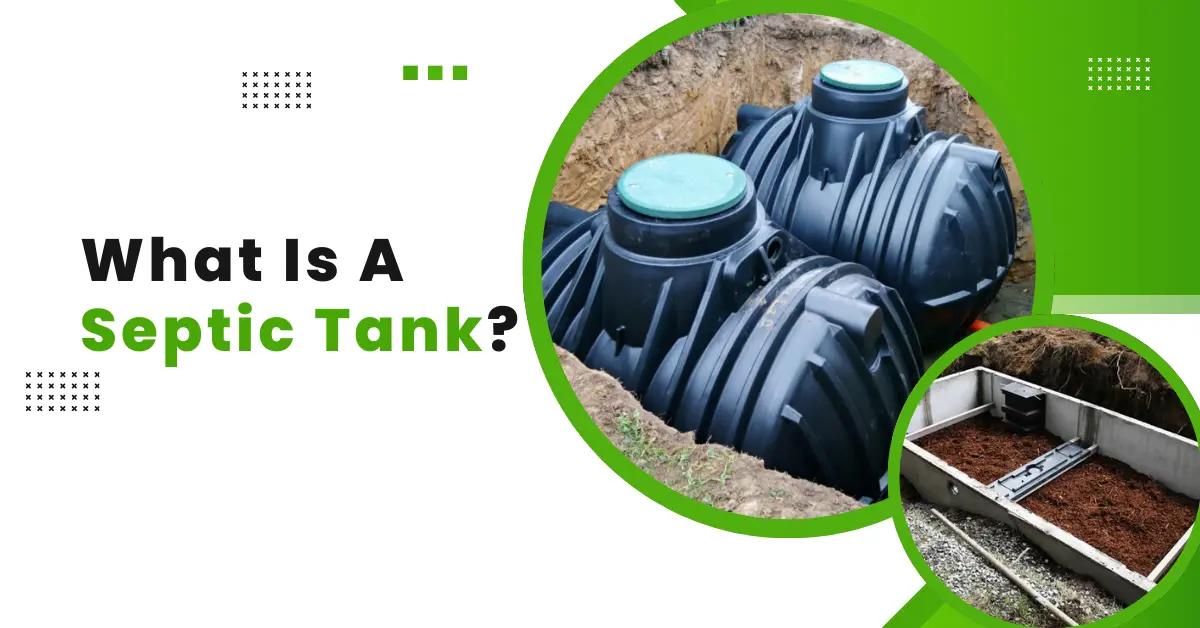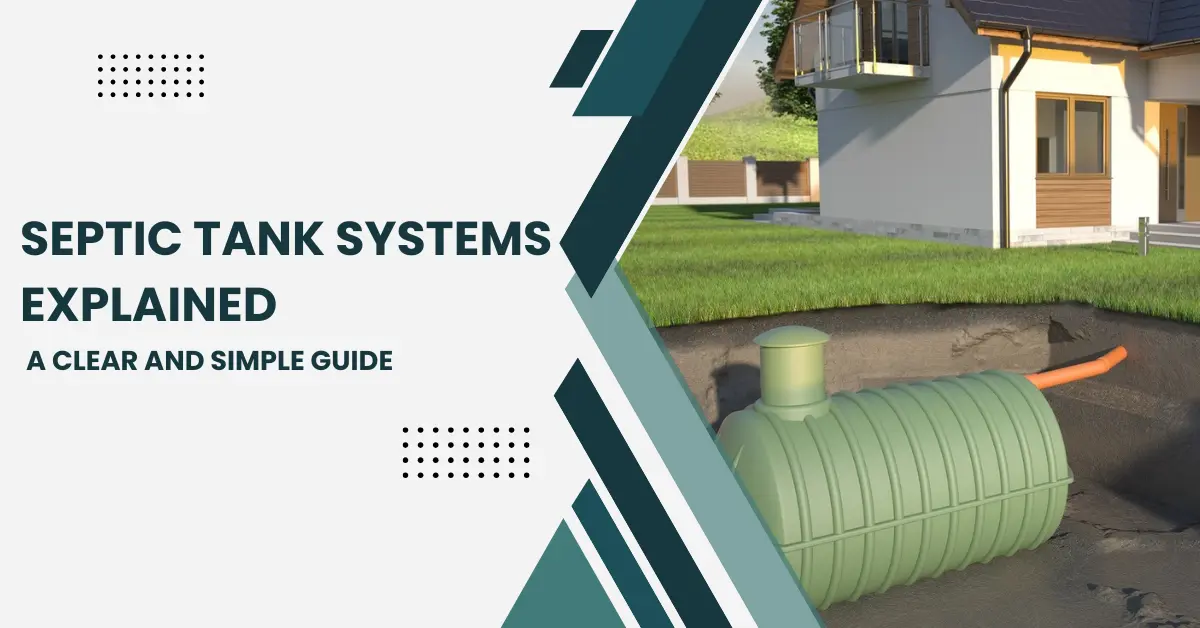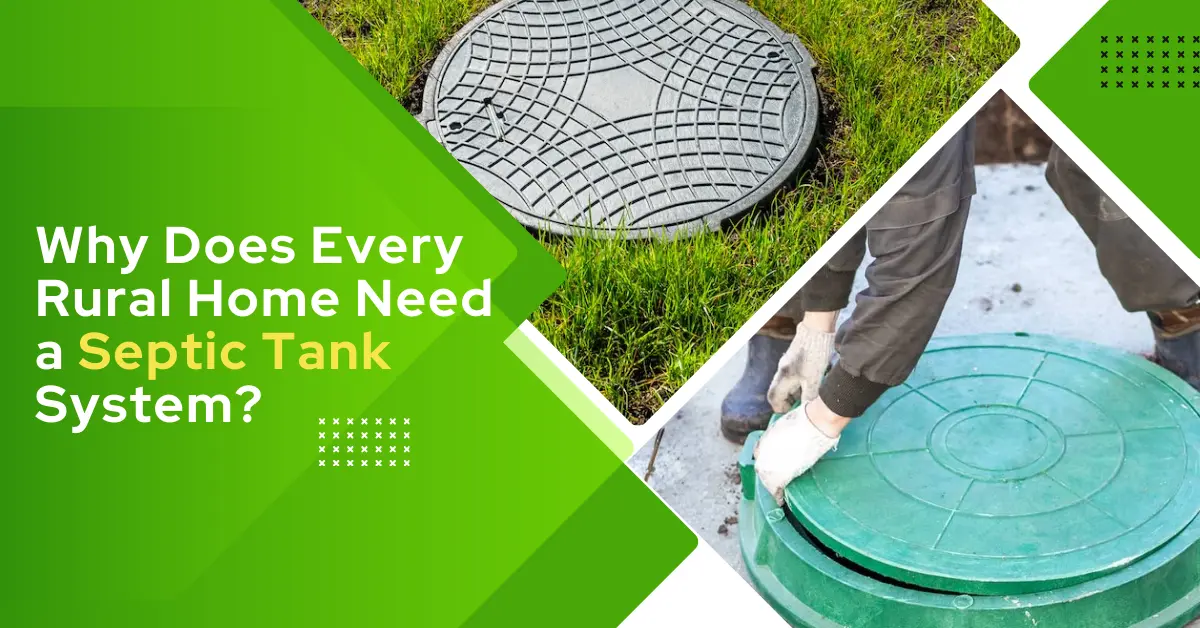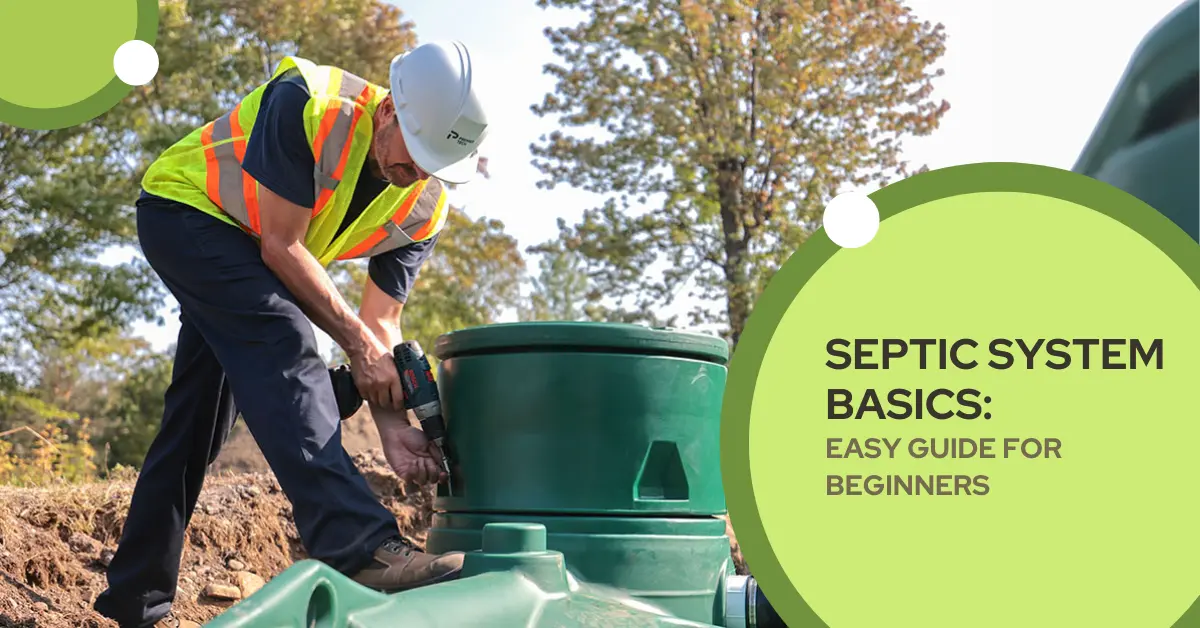Almost 1 in 5 households across the U.S. depend on septic tank systems to handle their sewage and wastewater. It’s especially common in rural and suburban communities, where access to city sewer lines just isn’t an option.
So, let’s define septic tank, and how does this self-contained system work to keep homes sanitary and wastewater properly treated?
A septic tank system is an underground setup made up of a tank, a drain field, and sometimes a soak pit. It quietly handles all your household wastewater.
Solids settle, oils rise, and the liquid gets filtered through the drain field. It quietly manages the sewage system of your home.
In this complete homeowner’s guide, we’ll break down how septic systems operate, compare them with outdated cesspools, explain signs of failure, and offer practical maintenance tips.
Whether you’re installing or maintaining a system, this guide covers septic tanks, plumbing basics, and eco-friendly wastewater solutions all in one place. Therefore, let’s get started!
Define Septic Tank?
A septic tank is an underground, watertight container designed to treat and dispose of domestic wastewater. The tank stores wastewater for about 24 hours.
It is built specifically for areas lacking centralized sewer systems. Made from concrete, fiberglass, or polyethylene, it utilizes natural processes to separate and partially decompose household sewage.
The septic tank acts as the first stage of a private onsite wastewater treatment system. It separates solids from liquids and enables the biological decomposition of organic matter.
Key Components of a Septic Tank
1. Inlet Pipe
For proper maintenance and functionality, understanding its components is crucial.
The wastewater from your home flows through the inlet pipe into the septic tank. Its role is to guide the sewage steadily into the tank without causing too much turbulence for initial treatment.
2. Septic Tank
The septic tank is buried underground and usually made of concrete, fiberglass, or polyethylene.
It temporarily holds wastewater and allows heavier solids to sink to the bottom (sludge) and lighter substances like oils and grease to float to the top (scum).
This separation process is essential for the initial treatment of sewage.
3. Baffles (Inlet and Outlet Baffles)
Baffles are simple but important structures positioned at both the inlet and outlet of the tank.
– The inlet baffle directs wastewater downward to reduce disturbance to the scum layer.
– The outlet baffle keeps solids and scum from flowing out of the tank. It also ensures that only the clarified liquid continues for further treatment.
4. Access Ports and Manhole Covers
These are openings on the top of the septic tank for inspection, maintenance, and pumping. Regular access is essential for monitoring the tank’s condition and ensuring its longevity.
5. Effluent Filter
An effluent filter is placed at the tank’s outlet. It serves as an additional barrier.
It catches smaller particles before they reach the drain field and helps prevent clogs and extends the system’s lifespan.
Cleaning it periodically is a must.
6. Outlet Pipe
Once the wastewater has been partially treated in the tank, the outlet pipe transports the liquid (effluent) to the drain field.
A clear, functioning outlet pipe is essential for proper flow.
7. Distribution Box
This small box spreads the effluent evenly across the drain field. By distributing the liquid evenly, it prevents overloading in one spot and ensures the soil can absorb and treat the wastewater properly.
8. Drain Field (Leach Field or Soil Absorption Field)
The drain field, also known as a leach field, consists of perforated pipes laid in gravel-filled trenches. It allows the treated water to seep out slowly into the surrounding soil, where nature continues the purification process.
9. Soil
Finally, the soil under the drain field acts as a natural filter. It removes lingering contaminants and pathogens.
It also ensures that the water returned to the groundwater is clean and safe.
Materials Used in Septic Tanks: Concrete, Fiberglass & Plastic
The material determines not only the durability and maintenance needs of your system but also its resistance to corrosion, environmental stress, and leaks.
Here’s a breakdown of each material and what you need to know.
1. Concrete Septic Tanks
Concrete is the most traditional and widely used material for septic tanks. It’s known for its strength and stability. It’s often the go-to choice for permanent installations.
Pros
- Long-lasting (30–40+ years with proper care)
- Strong structural resistance to external pressures
- Very stable on the ground (won’t float)
- Commonly accepted by health departments and regulators
Cons
- Heavy (requires crane or machinery for placement)
- Porous if not sealed properly (can leak over time)
- May crack over time due to ground settling or freeze-thaw cycles.
2. Fiberglass Septic Tanks
Fiberglass tanks are lightweight, non-porous alternatives that are growing in popularity due to their ease of installation and strong corrosion resistance.
Pros
- Lightweight and easy to install
- Non-corrosive (won’t rust or degrade from moisture or acidic soil)
- Non-porous, reducing leak risks
Cons
- More expensive than plastic
- Can crack if installed on uneven ground or exposed to heavy loads
- Prone to floating in high water table areas unless anchored.
3. Plastic (Polyethylene) Septic Tanks
Plastic or polyethylene septic tanks are the lightest and most budget-friendly option. These are ideal for properties with easy access and lower installation stress.
Pros
- Lightweight and affordable
- Rust- and corrosion-proof
- Quick to install without special equipment
Cons
- Less durable than concrete or fiberglass
- High buoyancy risk (can shift or float if not secured properly)
- Can warp or collapse under pressure
4. Steel Septic Tanks (Less Common Today)
Steel septic tanks were once widely used but are now considered outdated due to their limited lifespan and high maintenance requirements.
Pros
- Strong when new (can handle heavy loads)
- Compact and sturdy for tight installations
- May be suitable for temporary or emergency setups
Cons
- Short lifespan (as little as 15–20 years)
- Highly prone to rust and corrosion
- Often fail without visible warning (can collapse)
- Usually not approved for new installations in many jurisdictions
Why is Watertight Construction Essential?
Regardless of the material, a watertight septic tank is non-negotiable. Watertightness prevents:
- Leaching of untreated sewage into the environment
- Infiltration of groundwater, which can flood the system
- System failure and contamination of local water sources
Pro Tip: Always consult a licensed septic installer to evaluate your soil type, water table level, and property layout before choosing a material.
Types of Septic Systems: Which One Is Right for Your Property?
Below are the most commonly used septic systems worldwide, explained with clarity and precision.
1. Septic System (Gravity System)
This is the most traditional and widely installed septic system. This category is the best suited for homes with well-draining soil, plenty of yard space, and a low water table.
How it works
- Wastewater flows by gravity from the home to a septic tank.
- Solids settle, and the clarified effluent moves to a drain field where it filters through soil.
Pros
- Simple design
- Low maintenance
- Long lifespan when properly installed
Cons
- Not suitable for small lots or poorly draining soil
2. Chamber Septic System
This is a variation of the conventional system but uses chambers (plastic or concrete) instead of gravel in the drain field.
This system is ideal for areas where gravel is hard to find or where extra protection is needed in environmentally sensitive zones.
How it works
- Wastewater enters the tank and then flows into connected chambers in the drain field.
- The soil under the chambers treats the effluent.
Pros
- Easier and faster to install than gravel-based systems
- Reduces the carbon footprint
- Chambers can be more resistant to soil compaction
Cons
- Can be less durable than gravel systems
3. Aerobic Treatment Units (ATUs)
ATUs are advanced systems that use oxygen to treat wastewater, similar to small-scale municipal plants.
It’s great for properties with poor soil, high water tables, or limited space, and in locations that need advanced treatment, like those near lakes, rivers, or other water bodies.
How it works
- Air is pumped into the tank to stimulate aerobic bacteria.
- These microbes break down waste more efficiently than anaerobic systems.
- Often followed by a disinfection stage before effluent dispersal.
Pros
- High-quality effluent
- Smaller drain field needed
- Ideal for challenging sites
Cons
- Requires electricity
- More expensive to install and maintain
- Needs regular inspections and pumping
4. Mound Systems
Mound systems are used when the native soil is too shallow, rocky, or has a high water table.
It’s suitable for areas with shallow bedrock, heavy clay soil, or high groundwater levels where traditional systems might struggle..
How it works
- Wastewater is pretreated in a septic tank.
- It’s then pumped to a sand-filled mound constructed above ground.
- The effluent filters through the sand and into the soil beneath.
Pros
- Protects groundwater
- Customizable to difficult landscapes
- Allows treatment in places that conventional systems can’t
Cons
- Expensive to install
- Visually prominent (above-ground mound)
- Needs regular maintenance and monitoring
5. Soak Pits (Soakaways)
Soak pits are common in developing countries or older rural systems. These are simple yet effective disposal units.
Ideal for low-use rural homes or as emergency and backup wastewater systems.
How it works
- After basic treatment in a septic tank or cesspool, effluent flows into a perforated pit or chamber filled with gravel.
- The liquid seeps into the surrounding soil.
Pros
- Very inexpensive
- Easy to build
Cons
- Not allowed in many regulated areas
- Risk of groundwater contamination if overloaded
6. Drip Distribution System
A drip distribution system is an advanced septic setup that uses thin pipes to slowly and evenly spread treated wastewater into the soil, making it a gentle and efficient way to handle drainage.
This system is the best for sites with shallow soil, areas prone to surface runoff, and properties with uneven or sloped terrain.
How it works
- After primary treatment in the septic tank or aerobic unit, effluent is pumped through tubing equipped with drip emitters.
- The wastewater is distributed close to the surface, which allows gradual infiltration and absorption by the soil.
- This slow release minimizes saturation and promotes effective biological treatment.
Pros
- Reduces the risk of effluent surfacing
- Efficient use of land
- Adaptable to challenging landscapes
Cons
- Requires regular maintenance to prevent clogging
- Higher installation and operational costs compared to conventional systems
How Does a Septic Tank Work? (Step-by-Step Breakdown)
Below is a step-by-step guide that shows how septic tanks manage domestic sewage, wastewater, and ensure safe disposal through natural biological processes.
Step 1: Wastewater Flows from the Home into the Septic Tank
All wastewater from your home, such as kitchen, bathroom, laundry, and toilets, travels through the main plumbing line into the underground septic tank.
This tank is typically made of concrete, fiberglass, steel, or plastic and is watertight to prevent leaks or contamination.
Step 2: Separation into Sludge, Scum & Liquid Effluent
Once inside the tank, wastewater naturally separates into three layers,
- Sludge sinks to the bottom (heavy solids like human waste).
- Scum floats to the top (fats, oils, grease, and soap residues).
- Effluent (the partially treated liquid) remains in the middle.
The tank holds the waste long enough(24 hours) to allow this sedimentation process to occur.
Step 3: Anaerobic Bacteria Break Down Waste
Inside the tank, anaerobic bacteria (bacteria that don’t require oxygen) get to work.
They digest organic matter, break down solids into gases and liquids, and reduce the volume of waste. It prepares the effluent for safe disposal.
This biological treatment is the first and most crucial part of wastewater treatment.
Step 4: Effluent Flows into the Drain Field or Leach Field
Once separated, the effluent flows out of the tank through an outlet pipe into the drain field, also known as a soakaway system.
This area uses pipes with small holes buried in gravel to slowly release wastewater into the soil, where it’s naturally cleaned by helpful microbes.
Step 5: Soil Filters and Further Treats the Wastewater
As the wastewater soaks into the soil, natural microbes break down any leftover germs and nutrients.
This final step helps return clean water to the environment and safely replenishes the groundwater.
What Is the Difference Between a Septic Tank and a Sewer System?
While both septic tanks and sewer systems manage wastewater, they work very differently. Here’s a detailed comparison to help you understand.
| Feature | Septic Tank System | Sewer System (Municipal) |
| Definition | A private, on-site setup that treats sewage on the property | The government runs and sends waste to a central treatment plant |
| Location of Treatment | Wastewater is treated on-site | Wastewater is carried off-site |
| Ownership & Maintenance | The homeowner is responsible | Operated by local authorities |
| Lifespan | Tanks last 20 – 40 years | Sewer infrastructure lasts 50+ years |
| Space Requirements | Requires significant land space for the tank | No space needed on the property |
| Environmental Considerations | It can be eco-friendly | Discharged into local waterways |
| System Failure Impact | Cause backups or foul odors | Impacts entire communities |
| Cost | Lower initial costs | Higher initial fees & ongoing utility bills |
| Best Suited For | Rural areas without sewers. | Urban areas with swears |
Septic Tank vs. Cesspool: Key Differences
While both systems are underground and handle household wastewater, their function, design, and environmental impact differ significantly.
What Is a Cesspool?
A cesspool is also called a cesspit is a large, underground pit or container that collects sewage and wastewater without treatment temporary. Traditionally, it’s a porous chamber made of stone, brick, or concrete rings.
Unlike modern septic tanks that treat and filter waste, a cesspool simply collects raw sewage in a lined or unlined pit and allows liquid waste to seep directly into the surrounding soil.
Solids settle at the bottom and accumulate over time. This system is used in rural or undeveloped areas lacking centralized sewage systems.
However, due to environmental and health concerns, like groundwater contamination, odor issues, and overflow risks, cesspools have largely fallen out of favor and are even banned in some countries.
| Features | Cesspool | Septic Tank |
| Structure | Open pit or porous chamber | Sealed tank with inlet & outlet |
| Purpose | Waste collects & seeps out | Wastewater treated & clarified |
| Solids Handling | Accumulates in a pit | Solids settle into the sludge layer |
| Effluent Disposal | Directly into the soil | Directed to drain field/soak pit |
| Environmental Impact | High (groundwater/soil) | Low if well-maintained |
| Legal Status | Often banned or restricted | Widely accepted and regulated |
| Maintenance | Frequent pumping required | Less frequent |
Signs Your Septic Tank Is Full or Failing
Your septic tank quietly handles all of your home’s wastewater needs, but when it’s full or failing, it can cause serious plumbing problems and even environmental hazards.
Below are the most common signs, backed by information from trusted sources like the U.S. EPA, Plumbing industry experts, and global environmental health departments.
1. Slow Drains and Gurgling Sounds
According to the U.S. Environmental Protection Agency (EPA), if your sinks, toilets, and tubs are draining more slowly than usual or if you hear gurgling noises, this could be a sign that your septic tank is reaching its limit.
- This happens when too much solid waste blocks the pipes or outlet.
- It can also mean the drain field is clogged or soaked, causing a backup.
2. Sewage Backups into the Home
One of the most serious signs of septic system failure is sewage backing up into toilets, bathtubs, or floor drains.
- This usually means the tank is full or the outlet pipe is blocked, or damaged.
- It’s a serious health risk that requires professional attention to be addressed immediately.
3. Foul Odors Indoors or Outdoors
Persistent rotten egg or sewage smells around the house, especially near drains, the tank site, or the leach field, can indicate system overload or failure.
- These smells originate from gases such as methane and hydrogen sulfide leaking from the tank or drainage system.
- A properly functioning system should be odorless on the surface.
4. Pooling or Soggy Water Around the Drain Field
If you’re seeing standing water, lush grass, or overly soggy ground above your leach field or soak pit, the system may not be draining properly.
- This may happen if the leach field is clogged, the soil is compacted, or the tank is too full.
- A soaked drain field can’t filter properly, which can lead to system failure..
5. It’s Been 3–5 Years Since Your Last Pumping
According to the EPA’s Guide to Septage Treatment and Disposal, homeowners should have their septic tanks inspected and pumped every 3 to 5 years to ensure the system functions efficiently.
Neglecting this basic maintenance can cause solids to overflow into the drain field.
6. Frequent Need to Unclog Toilets or Drains
If you find yourself repeatedly plunging toilets or dealing with recurring clogs, the problem may not be your plumbing. It could be your septic tank.
- Too much waste or solids can block the system and damage its internal parts.
- This often happens when non-biodegradable items like wipes or sanitary products are flushed.
When to Call a Plumbing or Septic Professional?
Call a licensed septic technician or plumber immediately if you notice,
- Sewage backups
- Slow drainage throughout the house
- Gurgling or bubbling in toilets or sinks
- Surface pooling or smells
Septic Tank Maintenance
Proper maintenance of your septic system is crucial to ensure its longevity, prevent costly repairs, and protect the environment. Below are key practices every homeowner should follow.
1. Pumping Frequency (Based on Household Size)
Regular pumping is essential to prevent solid buildup that can clog and damage the septic system.
According to the U.S. EPA, septic systems should be professionally inspected at least once every 1 to 3 years.
In general, septic tanks need to be pumped every 3 to 5 years, though this timeline can vary based on several factors.
For example, a larger household produces more wastewater, which speeds up the accumulation of solids. High water usage overall can put additional strain on the system.
If your home uses a garbage disposal, even more solid waste enters the tank. It shortens the time between necessary pumpings.
The size of your septic tank also matters; larger tanks can store more waste.
2. Do’s and Don’ts for Flushing
What you flush down the toilet or pour down the drain can significantly impact your septic system’s health.
Do
- Flush only human waste and toilet paper.
- Use septic-safe cleaning products.
Don’t
Don’t flush non-degradable items such as,
- Feminine hygiene products
- Condoms
- Diapers
- Cigarette butts
- Dental floss
- Pharmaceuticals
- Cat litter
- Paper towels
Don’t pour household chemicals like bleach, drain cleaners, or paint down the drain. These can kill beneficial bacteria in the tank.
3. Protecting Your Drain Field from Damage
Dos
- Plant only grass over and near your drain field to prevent erosion.
- Keep roof drains, sump pumps, and other rainwater drainage systems away from the drain field area. Excess water can slow down or stop the wastewater treatment process.
Don’ts
- Drive or park vehicles on the drain field. This can compact the soil and damage pipes.
- Plant trees or shrubs near the drain field. Roots can grow into the system and cause blockages.
- Construct patios, carports, or other structures over the drain field.
Septic System Costs (2025 Estimates)
The cost of installing a septic system can vary based on several factors, including location, system type, and materials used. Here’s a breakdown:
Average Installation Cost
Between $3,610 and $12,412, with most homeowners spending around $8,011.
Tank Costs
- Plastic: Approximately $500 to $2,500.
- Fiberglass: Around $1,200 to $2,000.
- Concrete: Typically $700 to $2,000.
Additional Expenses
- Soil Testing: $7500 to $1,900.
- Permits: $450 to $2,300.
- Drain Field Installation: $3,000 to $10,000.
Permits and Compliance (Local Codes)
Proper installation and maintenance of septic systems are regulated to protect public health and the environment.
Permitting
In most states, local health departments issue construction and operating permits for septic systems.
Permits ensure that systems are designed and installed according to state and local regulations.
FAQs
1. Can I Flush Toilet Paper with a Septic Tank?
Yes, you can flush toilet paper in a septic system. The EPA advises that only toilet paper should be flushed, as it is designed to break down easily.
Avoid flushing items like wipes, feminine hygiene products, or paper towels, as they can clog the system and cause backups.
2. What’s the Lifespan of a Septic System?
A well-maintained septic system can last between 15 to 40 years. Factors influencing its lifespan include the materials used, soil conditions, water usage, and regular maintenance.
3. How Often Should a Septic Tank Be Pumped?
The EPA recommends that septic tanks be inspected every 1 to 3 years and pumped every 3 to 5 years.
The exact frequency depends on factors like household size, water usage, and tank size.
4. Are Septic Tanks Environmentally Friendly?
Yes, when properly maintained, septic systems are environmentally friendly. They treat wastewater on-site, reduce pollution, and replenish groundwater supplies.
5. What Are Common Problems with Septic Tanks?
Common issues include,
- Clogs and blockages are caused by flushing inappropriate items.
- Drainfield failures from overloading or poor maintenance.
- Odors indicate a full tank or system failure.
- Leaks due to cracks or damage in the tank or pipes.
6. How Big Should a Septic Tank Be for a Family of 4?
For a family of four, a septic tank with a capacity of 1,250 to 2,500 gallons is typically recommended.
The exact size depends on household water usage and local regulations.
Bottom Line
In conclusion, septic tanks offer an effective, self-contained solution for wastewater treatment in areas without access to centralized sewage.
By separating solids and directing effluent to a drain field, they protect public health and the environment when properly maintained.
Regular maintenance, such as pumping every 3 to 5 years and routine inspections by plumbing professionals, can help prevent backups, system failures, and costly repairs.
Responsible care, like using only septic-safe products, avoiding chemical flushes, and protecting your drain field, ensures your system stays healthy and environmentally safe.
Flush smart, live clean!





